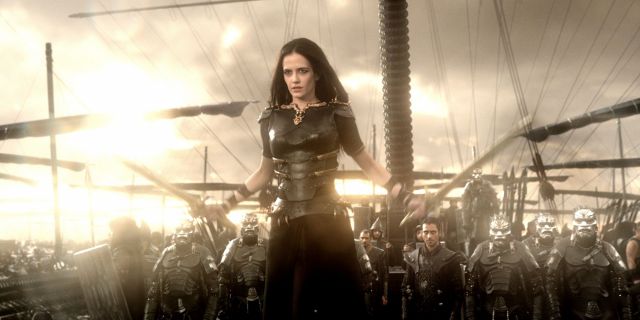Sequels can be hard to pull off. Capturing what worked or fixing what didn’t takes insight, creativity, and coordination. A significant gap between the two projects only makes everything more laborious. 300: Rise of an Empire struggled with that challenge, following up Zack Snyder’s box-office smash, 300. Critics were a little less kind to the sequel, and it made considerably less money, but is it worth returning to Frank Miller’s Greece?
300 has been reevaluated over the years, and the political debate centering on its themes is contentious. The depiction of the Spartans and their values is unapologetically fascist. Portraying them as heroes and tacitly endorsing their eugenics, militarism, and disgust with anything different borders on propaganda. It’s no wonder several modern fascists embrace the film as a perfect distillation of their ideology. Nor is it appealing in the broader context of Snyder’s grim filmography. Rise of an Empire doesn’t do enough to address these concerns, but it isn’t without introspection.
RELATED: WB Killed Zack Snyder’s Plans For A Third ‘300’ Movie
The 300 Sequel, Rise of an Empire, Explained

|
Director |
Noam Murro |
|---|---|
|
Writers |
Zack Snyder and Kurt Johnstad |
|
Cast |
Steven Stapleton, Eva Green, Lena Headey |
|
Release Date |
March 7th 2014 |
|
Runtime |
102 Minutes |
|
Box Office |
$337.6 Million |
300 is one of the most faithful adaptations in history. It’s a shot-for-shot translation that uses VFX to recreate the world seen on the page. Active production began in 2005 and cost only around $60 million, making the final project incredibly visually impressive from a modern perspective. It looks better than some features with nine-figure budgets do today. It’s a testament to what can be done when VFX professionals are given the necessary time. Work began on the sequel a year and a half after the first film hit theaters. Producers Gianni Nunnari, Mark Canton, and Bernie Goldmann discovered Frank Miller’s prospective follow-up to his 300 graphic novel. Zack Snyder was busy with Man of Steel but produced and co-wrote the project. Miller’s Xerxes wouldn’t come out until 2018, but parts became Rise of an Empire.
300: Rise of an Empire is set before, during, and after the original film. It follows Theomisticles, who killed King Darius of Persia many years before the Battle of Thermopylae Pass. Darius’s son, Xerxes, becomes the tyrant under the guidance of the impossibly capable warrior Artemisia. Naval conflict dominates the film, depicting massive encounters on the Aegean Sea. Theomisticles fights from the Battle of Marathon to the Battle of Artemisium before the grand climax at Salamis. Historians will have their heads in their hands, much like last time. It’s more of the same in many ways, but Theomisticles tries to shift toward a slightly more nuanced take on masculine heroism. Snyder pitched more sequels depicting the American Revolution or the Alamo. No progress has been reported.
300: Rise of an Empire is available to rent or buy on Amazon Prime Video.
Is 300: Rise of an Empire worth watching?

|
Rotten Tomatoes Critics Score: |
46% Positive |
|---|---|
|
Rotten Tomatoes Audience Score: |
51% Positive |
If one thing makes 300: Rise of an Empire worth watching, it’s Eva Green’s performance as Artemisia. She puts this movie on her back and carries it to a higher echelon. Director Noam Murro moves most of the action to the sea, swaps out the hero for someone slightly smarter, and almost manages to give women some credit. Those changes swerve the feature away from complete parity with the original. Without those choices, Rise of an Empire does nothing new. It’s more digital backlot shots borrowed from Frank Miller’s art and comically gratuitous blood. Visually, the sequel doesn’t improve upon 300. It’s a mixed bag with peaks that top the first film and valleys that sink well below it.
Politically, Rise of an Empire is no improvement on its predecessor. Anyone disgusted by the first film’s themes will find similar objections here. There isn’t a problem in 300 that Rise of an Empire fixes. It pushes its worst excesses to the same extremes. Critics complained about the excessive gore, which quickly blurs together into a pulpy red mess. They praised the inclusion of ladies in the battle scenes, conveniently leaving aside the fact that the film only respects women forged in the crucible of sexual assault. It’s grim. The first film didn’t age well. This one didn’t birth well.
300: Rise of an Empire manages to add some fresh notes and an excellent performance to its mix. Eva Green commands a vicious presence that deserves attention, but there’s not much worth seeing beyond her scenes. Fans of 300 who just want more wallpaper-ready visuals or VFX blood can do worse than this sequel, but they can also do much better. Anyone who doesn’t count Snyder’s 2007 ode to the worst ideas in the world among their favorite films can skip the sequel entirely. 300: Rise of an Empire was forgotten before its theatrical release window closed. Like every inferior kid in Sparta, it was tossed over the cliff before it had a chance. It’s a cruel fate, but blame them for endorsing it.











Leave a Reply